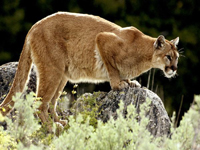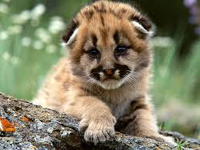

 |

|
 Mountain Lion |
Mountain Lion(Mammal) |
 Mountain Lion Baby |
Mountain Lion HabitsMountain lions are found in habitats as diverse as the cold, northern woods of Canada, the rocky, western country of the United states, and the tropical rainforests of Brazil. In Argentina, they live in the pampas, and their range extends to the southernmost tip of South America.
Instead of occupying a permanent den, mountain lions rest and find shelter in caves, among rocky outcrops, and in dense vegetation. They generally migrate from the mountains in winter to follow deer and other prey.
Once common across the western hemisphere, the mountain lion has been eradicated in many areas, and its survival is threatened. In some areas, mountain lions were wiped out in an attempt to protect deer populations. But eliminating a natural predator disrupted the balance of the environment. Consequently, the deer multiplied rapidly, and their habitat was unable to support the large population. |
Mountain Lion CommunicationMountain lions rely mainly on vision, smell, and hearing. They use low-pitched hisses, growls, purrs, yowls, and screams in different circumstances. Loud, chirping whistles by young serves to call the mother. Touch is important in social bonding between mother and young. Scent marking is important in advertising territory boundaries and willingness to mate. |
Mountain Lion BreedingThe territories of male mountain lions may overlap those of females, enabling the males to detect when the females are ready to mate. During a 14-day period of mating, a male and female will break their normally solitary habits to hunt together and sleep next to each other. The female later gives birth to two to six kittens in a carefully hidden den, located between rocks or in a cave.
Blind at birth the kittens have spotted coats until they are six months old. They begin to take meet provided by their mother at six weeks, while they are still suckling. Although they can hunt for themselves after nine months, they leave her and may stay together several months before wandering off to establish territories of their own. |
Mountain Lion Food & FeedingMountain lions are carnivores and generally hunt at dawn and dusk. Still, they are active by day in areas undisturbed by man. Like other cats, the mountain lion stalls its prey, sprinting after it if it attempts to flee. Then, pouncing on the animal's back with powerful leap that knocks it to the ground, the mountain lion kills its prey with a single bite to the nape of the neck.
Mountain lions have large hunting territories, and they eat most kinds of animals. Throughout their range, deer is their favorite meal. |
Mountain Lion Key Facts |
| Size |
| Height: To shoulder, 24-28 inches. Length: head and body, 5-6 feet. Tail length: 26-30 inches |
| Weight: 80-230 lbs |
| Breeding |
| Sexual maturity: Males, at least 3 years; Females, 2 years |
| Mating: Year-round. Females usually breed once every 2 years |
| Gestation: 60-96 days |
| Number of young: 2-6, usually 3-4 |
| Lifestyle |
| Habit: Solitary, generally hunt at dawn and dusk, but active by day in areas undisturbed by man |
| Diet: Mainly deer, most wild animals |
| Lifespan: Up to 22 years |
DID YOU KNOW?
|
CAN'T FIND WHAT YOU'RE LOOKING FOR? CLICK HERE!!!